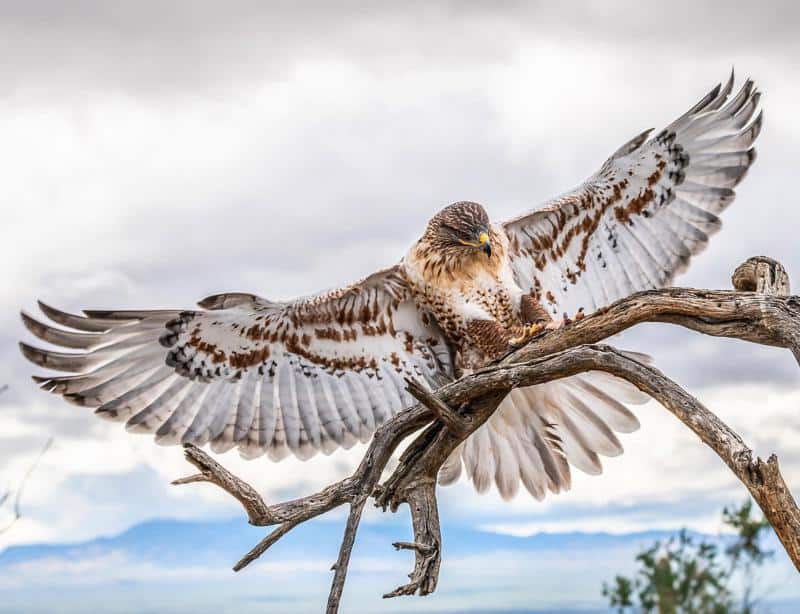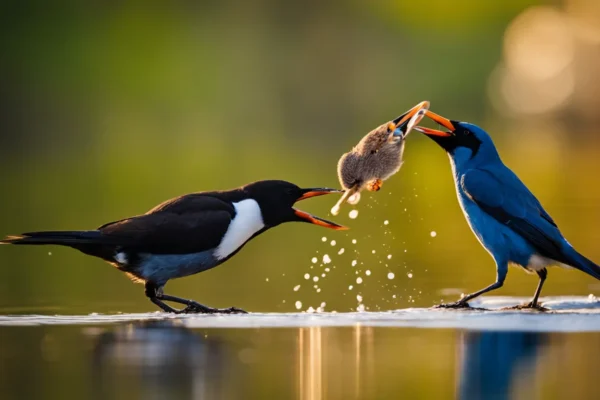Ornithologists and bird aficionados have long been enthralled by the vocalizations of birds, especially those of raptors like hawks. It becomes crucial to comprehend the many noises these intriguing animals make and their corresponding purposes as one gets further into their world.
Hawks are recognized for their characteristic shriek, which has been associated with these formidable predators in popular culture. This aural signal has many functions, including aiding in territorial displays and facilitating communication within the species.
Examining the many situations in which a hawk’s cry occurs and its importance for interspecific contact are essential to understanding the significance of this sound. The purpose of this page is to provide a general review of hawk vocalizations and to clarify the causes of their distinctive cry.
Additionally, as habitat degradation and human activity pose several risks to hawks, conservation initiatives will also be covered. Readers will be able to comprehend completely not just why hawks shriek, but also how these vocal cues help them survive and maintain the ecology of their native habitats.
Recognizing Hawk Vocalizations
Examining hawk vocalizations may provide important insights into the behavior and modes of communication of these magnificent birds. Hawks communicate by a range of sounds, each with a distinct message and purpose. Variations in vocalization may be ascribed to several variables, including age, species, and situation.
Comprehending the subtleties of these vocalizations aids scientists in interpreting the signals sent among hawks and their interactions with other animals. Hawk vocalizations are more complicated than basic screeches; they include a variety of sounds that have distinct meanings depending on the context.
For instance, some cries are used as warning signals or alarm calls in reaction to predators, while others are used to mark territory or draw in mates. Every call type has additional layers of significance due to changes in tone and pitch.
There will undoubtedly be more research done on these interesting animals as scientists continue to learn more about their sophisticated language. This information will not only help us comprehend hawks better, but it will also clarify the purposes for why their distinctive cry is used in different situations.
The Way a Hawk’s Screech Works
Analyzing the many intentions concealed by these raptors’ piercing scream provides crucial details about their communication, territorial demeanor, and hunting tactics.
Especially during mating season, when they employ vocalizations to attract partners and establish breeding territories, the scream is an essential means of communication for hawks.
These raptors may also use their screeches to alert other hawks to possible dangers or predators nearby, or even to indicate submission or hostility against their own species.
Moreover, several species have been seen to use their distinct screams to confuse their prey before diving in for the kill.
Thus, knowing how hawks communicate via their screeches might help us better grasp their ecological importance and intricate behavioral patterns.
According to a study, hawks can communicate over vast distances with other members of their own species using their characteristic cries, in addition to using them for mating rituals and predator alerts.
This skill is especially crucial for lone hunters who have to navigate large areas or find food sources by listening for conspecific cues instead of visual signs.
In the end, learning about the many purposes that hawk vocalizations fulfill improves our understanding of avian ecology and emphasizes how crucial it is to protect these amazing animals and their habitats in a world where environmental threats are becoming more and more severe.
This body of information will be essential as we learn more about the challenges facing hawks and the conservation initiatives put in place to keep them safe.
Dangers to Hawks and Preservation Initiatives
The influence of humans on hawk populations has grown significantly in the last several years due to threats to these important predators, including habitat loss, pesticide exposure, and direct persecution.
As a result, several conservation initiatives, such as habitat restoration programs and the creation of legislative safeguards, have been developed to safeguard and conserve these raptors.
Comprehending the difficulties encountered by hawks is vital in order to put into practice efficacious strategies that guarantee their enduring existence and uninterrupted ecological inputs.
Impact of Humans on Hawk Populations
Human activity has been linked to a startling 60% drop in certain hawk populations, highlighting the urgent need to address this problem.
Urbanization causes habitat loss and fragmentation, which is a major driver in this reduction. Hawks are forced to look for new territories or contend with competition from other displaced species as a result of the destruction or alteration of natural regions that serve as good nesting places and hunting grounds due to the continued growth of cities and towns. In addition, greater rates of death from auto accidents may result from the increasing availability of roads and other infrastructure.
The danger presented by human activity is not limited to habitat loss; exposure to and usage of pesticides also have a major role in population decreases. The accumulation of pesticides in hawks’ prey items may result in secondary poisoning that compromises general health and reproductive performance.
Moreover, certain areas continue to engage in illicit activities like the killing and trapping of these raptors for fun or because they are seen to be a nuisance. All of these things add up to the worrying global decline in hawk numbers.
Given this circumstance, governments and conservation groups have launched a number of initiatives with the goal of safeguarding and preserving these magnificent predators for next generations.
The Protection and Conservation of Hawks
With an emphasis on habitat restoration, research, and public awareness campaigns, conservation projects and initiatives have been launched in an effort to protect these important predators.
Understanding the dynamics, nutritional needs, migratory routes, and behavior patterns of hawk populations depends heavily on research.
Campaigns for public awareness aim to inform people about the value of hawks in preserving natural balance and encouraging cohabitation with wildlife.
The main goal of many conservation programs is to restore habitat. This includes reforestation, the creation or enhancement of wetland areas, and the management of grasslands to increase the abundance of prey species. All of these actions are meant to improve the conditions that favor hawk populations.
Nesting assistance: Conservation groups may provide artificial nest platforms or improve existing nest sites in situations when natural nesting sites are limited or affected by environmental causes or human activity. This will help to ensure successful breeding seasons.
Campaigns for public awareness: These aim to educate the public about the importance of hawks in ecosystems and potential conflicts with human interests (such as livestock predation). They do this by providing non-lethal alternatives, such as deterrents or habitat modifications, that can lessen unfavorable interactions between hawks and humans.
It is hoped that future generations will continue to see these magnificent birds soar high above our landscapes, carrying out their essential roles within our ecosystems, as a result of these coordinated efforts to conserve hawk populations and their habitats as well as to raise public awareness of the ecological significance of these birds.
Commonly Asked Questions
How many hawk species are there, and do they all make the same shrieking noises?
Many species of hawks have diverged as a result of hawk evolution, and each one has its own special traits and adaptations. There are more than 200 known species of hawks in the Accipitridae family, which includes buteos (broad-winged hawks), accipiters (hawks that live in forests), and harriers (hawks that live in grasslands).
These different species have different ecological niches, yet their vocalizations are comparable. Hawk species’ screech variants may vary significantly depending on body size, type of habitat, and social activity, but they all tend to have a high-pitched, piercing sound in common.
Across all hawk species, this distinctive shrieking sound plays vital roles in communication with conspecifics for territorial defense, mating attractiveness, and caring for chicks.
Are hawks born with their shrieking vocalizations, or do they acquire them through experience?
Scientists and ornithologists have been interested in hawk vocalizations, especially screech variants. Hawks communicate using vocalizations, which are vital for communicating signals like nesting cues or territorial claims.
Research indicates that a mix of natural tendencies and educational processes contribute to the formation of these screeches. Although hawks may vocalize from birth in some fundamental ways, young birds often develop their shrieking skills via contact with other hawks of the same species and exposure to adult sounds in their surroundings.
Therefore, it may be concluded that the patterns of shrieking shown by hawks are a combination of environmental and genetic elements, which gradually shape the bird’s vocal repertoire as it matures and adapts to different ecological and social circumstances.
What times of the day or certain weather patterns might cause a hawk to start screeching?
The seasons and weather may have an impact on hawk screaming triggers, among other things. When they are hunting or protecting their area, such as at dawn and dusk, these raptors are known to be more vociferous at certain times.
Furthermore, variations in temperature, wind direction, and air pressure may have an impact on the frequency and power of their shrieking vocalizations. The screech symbolism connected to these birds often stresses their acute senses and capacity to adapt to a variety of surroundings, which underscores the importance of comprehending the many components that contribute to their unique sounds.
Hawks can interact with one other and navigate their changing environment because of the complex interaction between environmental inputs and innate reactions.
Do hawks communicate with birds or animals other than members of their own species via their screech?
Hawks’ screech functions are mostly used for intraspecific communication, including mate attraction, territorial defense, and managing child care. These vocalizations, however, may potentially have an impact on predator-prey interactions since some animals have been shown to react to the alarm cries of other species.
Although the particular effects of hawk shrieking on birds or animals other than members of their own species have not been thoroughly studied, it is conceivable that sympatric fauna may perceive hawk sounds as warning signs of danger or approaching threat.
Thus, further research on the possibility of hawk screeches facilitating interspecific communication would provide light on the intricacy of animal communication networks and bird ecology.
Does a hawk’s activity or presence in its area impact how often or how loudly it screeches?
The frequency and intensity of hawks’ shrieking may be affected by human activity or presence in their region because these raptors may see human encroachment as a danger to their resources or safety.
Humans have attempted a variety of strategies to dissuade hawks, including reflecting devices, noise-makers, and even falconry with trained prey to cause the birds to make defensive sounds when they sense danger.
Moreover, screech interpretations imply that hawks may modify the loudness and pitch of their sounds in response to the particular situation and level of human irritation.
This emphasizes how crucial it is to understand bird communication patterns in order to reduce the likelihood of confrontations between people and animals and to encourage coexistence in shared habitats.
Final Thoughts
A hawk’s mysterious cry fulfills a variety of functions in its biological niche, including communicating with prospective mates and marking the limits of its territory. Their ability to vocalize is essential to their social connections and survival.
Hawk conservation efforts may benefit from an awareness of their unique sounds as they continue to confront a variety of environmental difficulties. Similar to the melodic symphony of the great orchestra of nature, the distinct songs of these birds play a vital role in the intricate web of life that has to be conserved for future generations.






